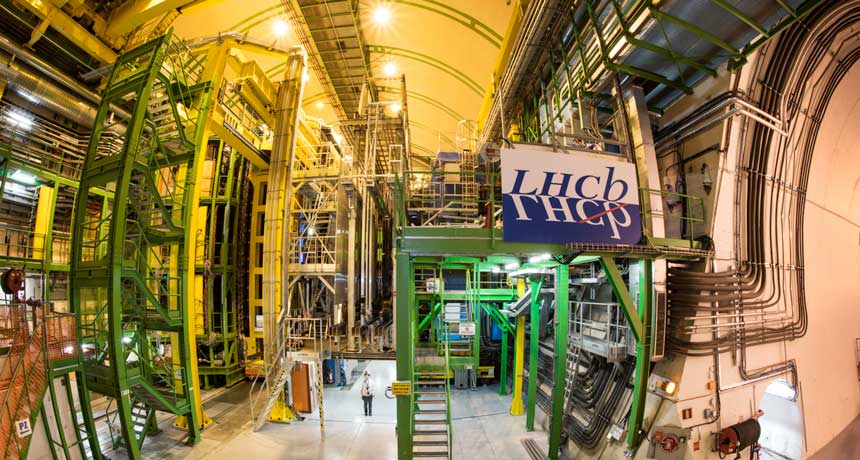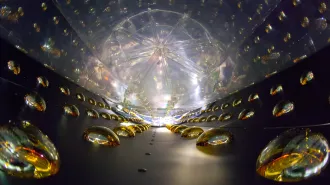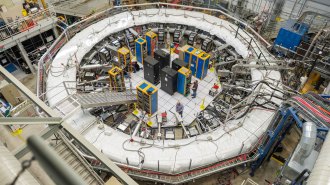Collider data hint at unexpected new subatomic particles
Shortage of muons in B meson decay looks suspicious, but needs confirmation

WEIRD DECAYS Something funny may be going on in certain particle decays measured in the LHCb experiment in Geneva (above). A new measurement has now added to scientists’ suspicions.
Maximilien Brice/CERN
- More than 2 years ago
A handful of measurements of decaying particles has seemed slightly off-kilter for years, intriguing physicists. Now a new decay measurement at the Large Hadron Collider in Geneva has amplified that interest into tentative enthusiasm, with theoretical physicists proposing that weird new particles could explain the results. Scientists with the LHCb experiment reported the new result on April 18 in a seminar at the European particle physics lab CERN, which hosts the LHC.
“It’s incredibly exciting,” says theoretical physicist Benjamin Grinstein of the University of California, San Diego. The new measurement is “a further hint that there’s something new and unexpected happening in very fundamental interactions.”
Other physicists, however, are more cautious, betting that the series of hints will not lead to a new discovery. “One should always remain suspicious of an effect that does not show up in a clear way” in any individual measurement, Carlos Wagner of the University of Chicago wrote in an e-mail.
Taken in isolation, none of the measurements rise beyond the level that can be explained by a statistical fluctuation, meaning that the discrepancies could easily disappear with more data. But, says theoretical physicist David London of the University of Montreal, there are multiple independent hints, “and they all seem to be pointing at something.”
The measurements all involve a class of particle called a B meson, which can be produced when protons are smashed together in the LHC. When a B meson decays, it can produce a type of particle called a kaon that is accompanied either by an electron and a positron (an antimatter version of an electron) or by a muon — the electron’s heavier cousin — and an antimuon.
According to physicists’ accepted theories, muons and electrons should behave essentially identically aside from the effects of their differing masses. That means the two kinds of particles should have an even chance of being produced in such B meson decays. But in the new result, the scientists found only about seven decays with muons for every 10 with electrons.
There are several varieties of B mesons. All are made up of one quark — a type of fundamental particle that also makes up protons and neutrons — and one antiquark. One of the two particles is a type called a “bottom” quark (or antiquark), hence the B meson’s name.
Earlier measurements of another variety of B meson decay also found a muon shortage. What’s more, measurements of the angles at which particles are emitted in some types of B meson decay also appear slightly out of whack, adding to the sense that something funny may be going on in such decays.
“We are excited by how [the measurements] all seem to fit together,” says LHCb spokesperson Guy Wilkinson, an experimental physicist at the University of Oxford in England. If more data confirm that B mesons misbehave, a likely explanation would be a new particle that interacts differently with muons than it does with electrons. One such particle could be a leptoquark — a particle that acts as a bridge between quarks and leptons, the class of particle that includes electrons and muons. Or it could be a heavy, electrically neutral particle called a Z-prime boson.
Physicists spawned a similar hubbub in 2016, when the ATLAS and CMS experiments at the LHC saw hints of a potential new particle that decayed to two photons (SN: 5/28/16, p. 11). Those hints evaporated with more data, and the current anomalies could do likewise. Although the two sets of measurements are very different, says Wolfgang Altmannshofer of the University of Cincinnati, “from the point of the overall excitement, I would say the two things are roughly comparable.”
Luckily, LHCb scientists still have a lot more data to dig into. The researchers used particle collisions only from before 2013, when the LHC was running at lower energy than it is now. “We have to get back to the grindstone and try and analyze more of the data we have,” says Wilkinson. Updated results could be ready in about half a year, he says, and should allow for a more definitive conclusion.







